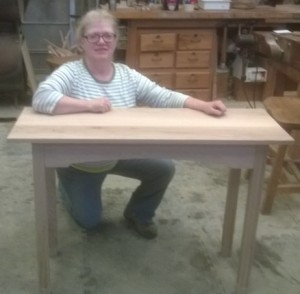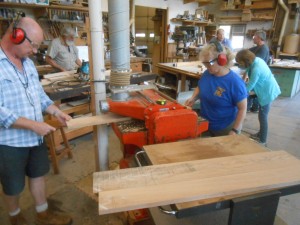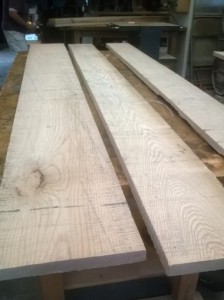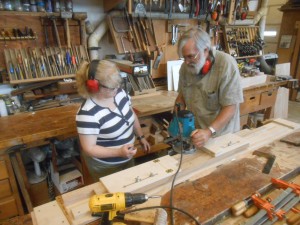 It’s not a secret to anyone, I think, that I love taking workshops. Learning new stuff is something that I dearly love to do. But over the years, I’ve come to realize that there are really several different sorts of workshops and of course people have all different sorts of reasons why they are taking them. Here are a few important things to remember when researching workshops to learn something specific. My most recent workshop was in woodworking but I think these are worthwhile when you are looking for any sort of workshop.
It’s not a secret to anyone, I think, that I love taking workshops. Learning new stuff is something that I dearly love to do. But over the years, I’ve come to realize that there are really several different sorts of workshops and of course people have all different sorts of reasons why they are taking them. Here are a few important things to remember when researching workshops to learn something specific. My most recent workshop was in woodworking but I think these are worthwhile when you are looking for any sort of workshop.
1. Be honest with yourself.
What are you looking to get out of the workshop? If you are already doing the activity (whether it’s sewing, knitting, carpentry, welding, gardening, whatever), what is it that you are trying to achieve by taking a workshop? Learning or upgrading your skills? Learning how to do a specific thing (as in a workshop advertised as ‘Making a tailored suitcoat’ or ‘making the Oscar de la Renta xxx dress’)? Or learning or improving skill sets (‘tailoring techniques’)? Learning tips or tricks that will make doing the activity more efficient and satisfying? Be clear with yourself what you want to learn and the way you want to learn it so that when you are done with the workshop, the voice in your head is saying, ‘Hey, I loved that – it was exactly what I needed and I’m ready to go home and put these things into play’ rather than, “I’m no better off than I was before the workshop; it was a waste of time.”
2. Be honest with yourself about what your skill level already is.
3. Be honest with yourself about what level of effort you are willing to put into this workshop. Some people go to workshops for the entertainment value alone and that is not a sin, but don’t go looking for a workshop that details ‘8 hours of actual hands-on work per day’ if that is not where your head is at. You’ll only get frustrated with yourself and become a rather unpopular member of the class.
4. Be honest about what by-products you are willing to accept as a result of the workshop. If you go to a workshop where they are making a very specific thing (glassware, furniture, formal dress, wool suit for example), what level of perfection/professionalism are you expecting to achieve. Some of this is definitely related to number 2 above, but a lot of this is in YOUR head.
5. Think through what you really want to have happen in the course. If you are someone who gets frustrated with lecture presentations, make sure you read the descriptions carefully so that you do not choose a workshop where slide presentations are a part of this. Part of your job in a workshop is not only to do your work, keep on schedule, follow directions and so on; it’s also to be a good and contributing member of the class and if you are squirming in your seat while the teacher is showing slides on how sewing machines actually work, or the layers in a compost pile, your classmates are not going to feel very friendly.
6. Do you expect a lot of personalized attention? I’ll illustrate this with a photo of me at the p laner. If you click on the photo, you will ‘enbiggen’ it and you’ll be able to see the details I’m describing here. OK – I am feeding my pieces of wood into the planer to smooth them out to make a tabletop. The gentleman at the back of the planer who is supporting me, talking me through the activity is one of the teachers there, Eoin (which is pronounced Owen). To the rear of the photograph is the head teacher, who also owns the workshop and furniture-making studio, Jeff Lohr. He’s setting up a jig for a demonstration for the class and showing something to another student that you can’t see for the pipes just behind me which are feeding the dust collection system. On the right hand side, to the rear, is another one of the teachers, Rob, who is demonstrating an activity to another student at one of the table saws. And right behind me is another student who has already been trained on the use of this particular piece of equipment and is feeding a piece of wood through the jointer. We are all wearing safety glasses. Eoin and I are also wearing hearing protection because a planer is really noisy. Missing from this picture (and probably demonstrating to other students elsewhere in the shop) is the fourth teacher, Larissa. Four teachers for 11 students. Lots and lots of attention and availability. If you are the sort of person who wants/needs/expects to have your hand held through an activity (again, this is not a sin and goes back to your skill level and level of confidence), then make sure you research the student/teacher ratio for the workshop. The description doesn’t say? Then contact the workshop and ask.
laner. If you click on the photo, you will ‘enbiggen’ it and you’ll be able to see the details I’m describing here. OK – I am feeding my pieces of wood into the planer to smooth them out to make a tabletop. The gentleman at the back of the planer who is supporting me, talking me through the activity is one of the teachers there, Eoin (which is pronounced Owen). To the rear of the photograph is the head teacher, who also owns the workshop and furniture-making studio, Jeff Lohr. He’s setting up a jig for a demonstration for the class and showing something to another student that you can’t see for the pipes just behind me which are feeding the dust collection system. On the right hand side, to the rear, is another one of the teachers, Rob, who is demonstrating an activity to another student at one of the table saws. And right behind me is another student who has already been trained on the use of this particular piece of equipment and is feeding a piece of wood through the jointer. We are all wearing safety glasses. Eoin and I are also wearing hearing protection because a planer is really noisy. Missing from this picture (and probably demonstrating to other students elsewhere in the shop) is the fourth teacher, Larissa. Four teachers for 11 students. Lots and lots of attention and availability. If you are the sort of person who wants/needs/expects to have your hand held through an activity (again, this is not a sin and goes back to your skill level and level of confidence), then make sure you research the student/teacher ratio for the workshop. The description doesn’t say? Then contact the workshop and ask.
I will use myself as the example for going through this process:
1. What was I looking to get out of the workshop? I’ve been noodling around with the idea of woodworking for a long time. I even made my grandson a table for his toy trains. I wasn’t satisfied with it by any means but it showed me I could use a Kreg(tm) jig and a power drill and not injure myself. I have wanted to make other, nicer things ever since but had this huge fear of big power equipment and not doing things properly. So, for me, I went looking for a workshop where I was going to get a lot of safety training and practice using big, noisy, dangerous stuff and come out with confidence, a way of working and all my fingers still attached. When I looked in the workshop descriptions, safety and lots of hands-on practice were two things I looked for.
2. Skill level: I was honest – I didn’t know much of anything and my skills were non-existent. So, I looked for a workshop where the description actually called out something of the ‘We love newbies’ sort.
3. What level of effort was I willing to put in? Well, I have to admit that I have not had to put in 8 hours on my feet doing physical labor in a very long time, so I was not realistic about that. I read the descriptions and it sounded fine to me and I was willing to do it. Thank goodness I brought good supportive boots with me. Standing on your feet for 8 hours (or sitting at a sewing machine for hours on end) is hard work. At the end of every day, I would go back to the hotel, stand in the shower, take two aspirin and then lay on the floor with bags of ice on my arms because they ached.
4. The by-product.  I didn’t worry about that since I was looking for practice and skills-building. The stated project for the class (as you see from the photo at the top) was a console table, but it’s just the instrument to teach and give the students practice taking what you see here – three rough-sawn oak boards and then moving them through the process of cutting, smoothing, and shaping to transform them into the table at the top. To do that, we needed to learn how to:
I didn’t worry about that since I was looking for practice and skills-building. The stated project for the class (as you see from the photo at the top) was a console table, but it’s just the instrument to teach and give the students practice taking what you see here – three rough-sawn oak boards and then moving them through the process of cutting, smoothing, and shaping to transform them into the table at the top. To do that, we needed to learn how to:
Read a plan, not only to figure out what you have to make, but also how to figure out just how much wood you need to make the project.
Figure out what pieces of the different pieces of wood would look to best advantage as the tabletop, the legs and the skirting boards.
Measure the wood to the proper sizes
Cut the wood using a table saw safely and properly
Smooth the pieces of wood using the jointer and planer, again safely and properly
Deal with naturally-occurring problems in a safe and effective manner (for example, the piece of wood that I had chosen for my legs had an issue referred to as ‘case hardening’ so it behaved in a very untrustworthy way in the table saw; they trained me how to use the bandsaw to cut the pieces safely).
Glue and clamp up pieces of wood to make legs and a tabletop
Use routers to not only make decorative details but also to cut mortises in the legs but also use it in a jig as a planer.
Use a table saw to cut tenons on the skirting pieces to fit into the mortises
Use clamps and a measuring tape to dry fit and then glue up the table frame and make it square
Yes, I got a table made, but look at all the different skills I learned while I was there which will help me make basically anything I want to make from now on. And do it safely and efficiently.
5. Lecture presentations: Some of what was covered was not new to me, but most of it was and hearing the students’ questions was really good. We had a lot of people with a lot of experience there. A lot of the presentations, such as those on sharpening for chisels, scrapers and the blades on planes was completely new and very fascinating. I also learned a new method of finishing furniture, with boiled linseed oil and how to fix cracks and other faults in boards using 2-part epoxy and fine sawdust. Great stuff.
6. Personalized Attention: I’ve taken workshops with one teacher for 8 students, which seems pretty low, but when you are standing around for 10 minutes waiting for the teacher to finish with another student so that you can ask your question, it can get very frustrating for me, so I knew that I wanted a learning situation where I could snag a teacher very quickly. In this case, Jeff is demonstrating the proper way to hold the plunge router and use the jig on the table to get the mortises cut in the right sides and ends of the legs of the table. In this case, Jeff ascertained really quickly that because I’m short, it would not be a safe work situation for me and he created a platform, right there, for me to stand on to work. That’s what I call personalized attention.
Personalized Attention: I’ve taken workshops with one teacher for 8 students, which seems pretty low, but when you are standing around for 10 minutes waiting for the teacher to finish with another student so that you can ask your question, it can get very frustrating for me, so I knew that I wanted a learning situation where I could snag a teacher very quickly. In this case, Jeff is demonstrating the proper way to hold the plunge router and use the jig on the table to get the mortises cut in the right sides and ends of the legs of the table. In this case, Jeff ascertained really quickly that because I’m short, it would not be a safe work situation for me and he created a platform, right there, for me to stand on to work. That’s what I call personalized attention.
So, to review quickly:
Know what you don’t know.
Know what you want to learn.
Know what you want to walk away from the workshop knowing.
Know what you want to walk away from the workshop having.
Know how much effort you are willing to put in.
Know what your best learning style is.
Know how much personal attention you want/need/expect.
Now you can do your research accordingly so that you can achieve a happy result.
Now, a personal note on this woodworking workshop (J.D. Lohr School of Woodworking Practical Woodworking). Taking this workshop was really sort of a ‘make or break/can I really do this’ sort of effort. If I had had a completely frustrating experience with poor results, I probably would be sitting here writing, “well, I can cross woodworking as an endeavor off the list.’ I went there with basically no experience and was surrounded by 10 other students, most of whom had a good deal of experience and some of whom had been making furniture of various kinds for years and had a lot of experience at the table saw, jointer and planer. I felt I held my own against a lot of them and came away with a fairly realistic enthusiasm for the next steps I’ll need to take now. There are plenty of furniture-making workshops out there and usually they are very specific, almost to the point where you have the pieces of wood pre-packaged for you. But this is really a skills-building workshop and I feel that this was exactly what I needed right now – to take away my ‘fear of blades’ and give me confidence to move on and make more nice things out of wood. I’ve got my list ready!!
(Photos courtesy of J.D. Lohr School of Woodworking
